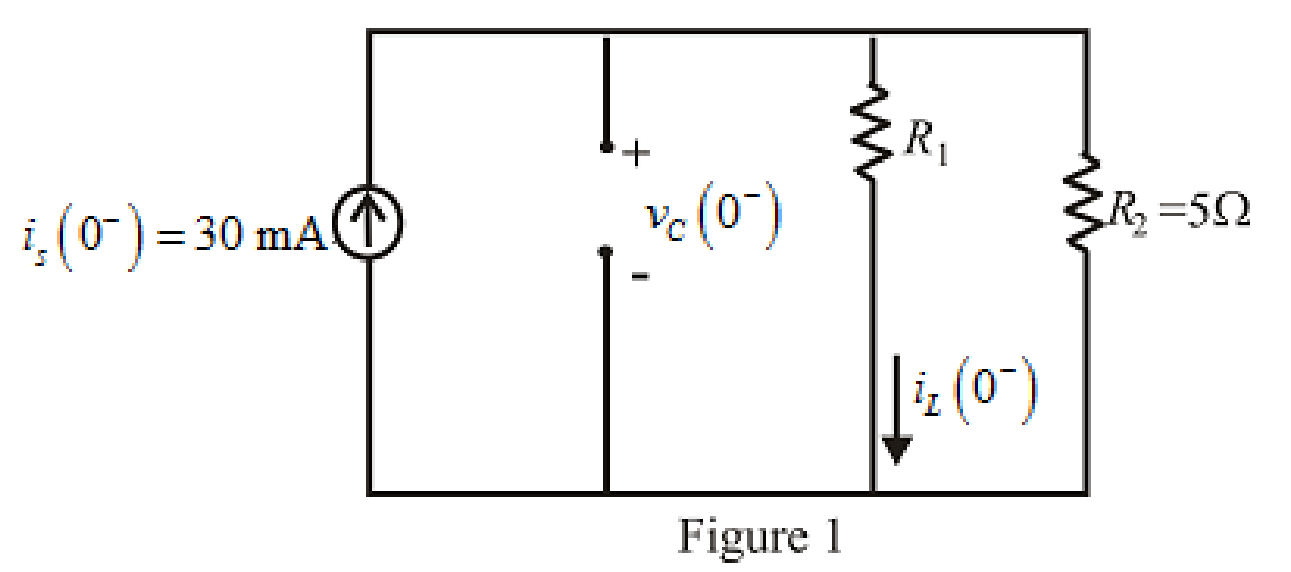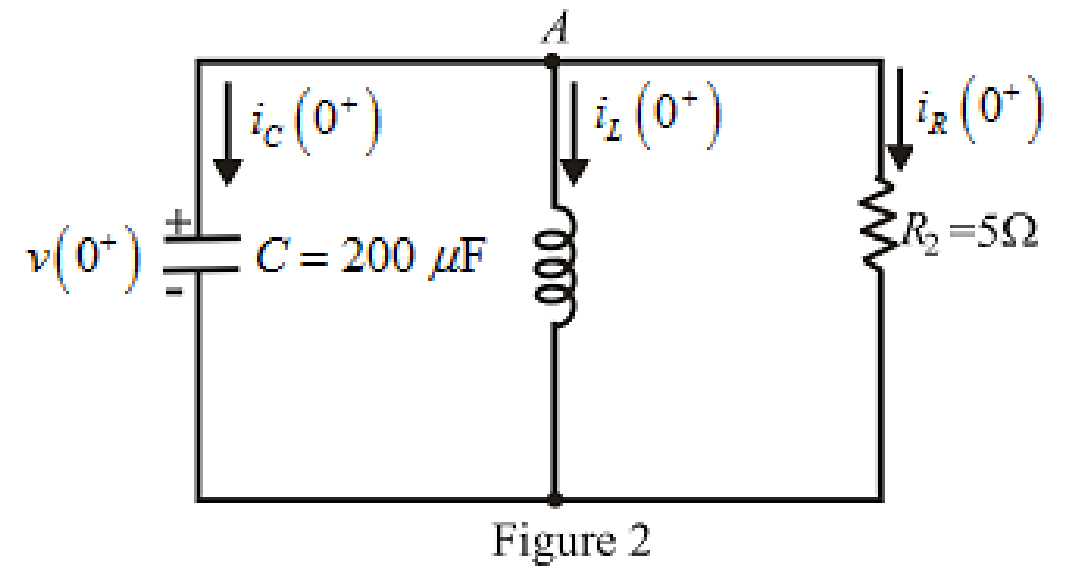
For the circuit of Fig. 9.45, is(t) = 30u(−t) mA. (a) Select R1 so that v(0+) = 6 V. (b) Compute v(2 ms). (c) Determine the settling time of the capacitor voltage. (d) Is the inductor current settling time the same as your answer to part (c)?

FIGURE 9.45
(a)
Select
Answer to Problem 26E
The resistance
Explanation of Solution
Given Data:
Formula used:
The expression for the exponential damping coefficient or the neper frequency is as follows:
Here,
The expression for the resonant frequency is as follows:
Here,
The expression for a critically damped response of a source free parallel RLC circuit is as follows:
Here,
Calculation:
The unit-step forcing function as a function of time which is zero for all values of its argument less than zero and which is unity for all positive values of its argument.
Here,
So, at
The redrawn circuit diagram is given in Figure 1 at

Refer to the redrawn Figure 1:
The expression for the current through the inductor at
Here,
The expression for the voltage across the capacitor at
Here,
Substitute
The capacitor does not allow sudden change in the voltage, so,
The voltage across the capacitor at
Substitute
Rearrange for
The resistance cannot be negative so, the resistance
Conclusion:
Thus, the resistance
(b)
Compute
Answer to Problem 26E
The value of the voltage
Explanation of Solution
Given data:
The time is
Calculation:
Substitute
The inductor does not allow sudden change in the current.
So,
So the current through inductor at
The redrawn circuit diagram is given in Figure 2 at

Refer to the redrawn Figure 2:
The expression for the current flowing in the
Here,
Substitute
Apply KCL at node
Here,
Substitute
Rearrange for
Substitute
Substitute
Substitute
Substitute
The voltage across the capacitor at
Substitute
Rearrange for
The expression for the current flowing through the
Substitute
Rearrange for
Substitute
The current flowing through the
Substitute
Substitute
Rearrange for
Substitute
Substitute
Conclusion:
Thus, the value of the voltage
(c)
Determine the settling time of the capacitor voltage.
Answer to Problem 26E
The settling time of the capacitor voltage is
Explanation of Solution
Calculation:
The maximum voltage appears across the capacitor at
So, for maximum voltage,
Substitute
Settling time is the time at which the value of the voltage reaches
The expression for the voltage at
Here,
Substitute
Substitute
The value of
Conclusion:
Thus, the settling time of the capacitor voltage is
(d)
Is the inductor current settling time the same as your answer to part (c)?
Answer to Problem 26E
The inductor current settling time is not same as capacitor voltage settling time.
Explanation of Solution
Calculation:
The expression for the current through inductor is as follows:
Here,
Substitute
Simplify further.
The maximum current through the inductor is at
So, for the maximum current,
Substitute
Settling time is the time at which the value of the current reaches
The expression for the current at
Here,
Substitute
Substitute
Rearrange equation (22).
The value of
So the inductor current settling time is
Conclusion:
Thus, the inductor current settling time is not same as capacitor settling time.
Want to see more full solutions like this?
Chapter 9 Solutions
ENGINEERING CIRCUIT...(LL)>CUSTOM PKG.<
- Add a second start button to the basic circuit so Start Button 1 or Start Button 2 can be used to start a motor. Include a second stop button that is connected so that Stop Button 1 or Start Button 2 can be used to stop the motor.arrow_forwardCircuit Logic. Match each statement to the proper circuit. All circuits have been drawn with a light (L) to represent the load, whether it is a motor, bell, or any other kind of load. In addition, each switch is illustrated as a pushbutton whether it is a maintained switch, momentary switch, pushbutton, switch-on target, or any other type of switch. from electrical motor controls for integrated systems workbook 2014 chapter 5arrow_forwardAssume ideal op-amp. If V_DC= 2.9, find I_L in mAarrow_forward
- R is 12 kΩ . Find the Thevenin equivalent resistance.arrow_forwardAssuming an ideal op-amp, design an inverting amplifier with a gain of 25 dB having the largest possible input resistance under the constraint of having to use resistors no larger than 90 kΩ. What's the input resist?arrow_forwardI need help with this problem and an explanation of the solution for the image described below. (Introduction to Signals and Systems)arrow_forward
 Introductory Circuit Analysis (13th Edition)Electrical EngineeringISBN:9780133923605Author:Robert L. BoylestadPublisher:PEARSON
Introductory Circuit Analysis (13th Edition)Electrical EngineeringISBN:9780133923605Author:Robert L. BoylestadPublisher:PEARSON Delmar's Standard Textbook Of ElectricityElectrical EngineeringISBN:9781337900348Author:Stephen L. HermanPublisher:Cengage Learning
Delmar's Standard Textbook Of ElectricityElectrical EngineeringISBN:9781337900348Author:Stephen L. HermanPublisher:Cengage Learning Programmable Logic ControllersElectrical EngineeringISBN:9780073373843Author:Frank D. PetruzellaPublisher:McGraw-Hill Education
Programmable Logic ControllersElectrical EngineeringISBN:9780073373843Author:Frank D. PetruzellaPublisher:McGraw-Hill Education Fundamentals of Electric CircuitsElectrical EngineeringISBN:9780078028229Author:Charles K Alexander, Matthew SadikuPublisher:McGraw-Hill Education
Fundamentals of Electric CircuitsElectrical EngineeringISBN:9780078028229Author:Charles K Alexander, Matthew SadikuPublisher:McGraw-Hill Education Electric Circuits. (11th Edition)Electrical EngineeringISBN:9780134746968Author:James W. Nilsson, Susan RiedelPublisher:PEARSON
Electric Circuits. (11th Edition)Electrical EngineeringISBN:9780134746968Author:James W. Nilsson, Susan RiedelPublisher:PEARSON Engineering ElectromagneticsElectrical EngineeringISBN:9780078028151Author:Hayt, William H. (william Hart), Jr, BUCK, John A.Publisher:Mcgraw-hill Education,
Engineering ElectromagneticsElectrical EngineeringISBN:9780078028151Author:Hayt, William H. (william Hart), Jr, BUCK, John A.Publisher:Mcgraw-hill Education,





